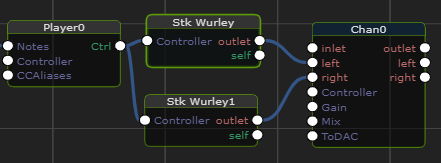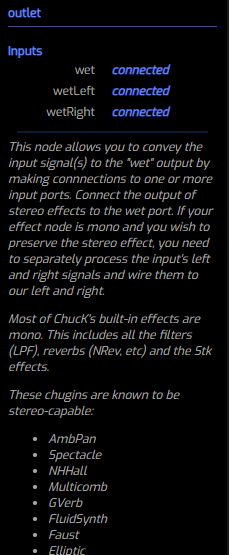/ Examples / Effects / Stereo Effects
NoteStreams .. Instruments
Filters .. Effects .. LiCK Effects
Plot .. Utility .. Pure ChucK
Wherein we focus on effects chains for stereo signals.
Right-click to copy examples to your workspace
Stereo Effects
In most cases a simple chain comprised of sound generator and Channel is sufficient to deliver your ideas to ears. If your sound generator produces a stereo signal (cf GrainBuf), you may need to take special care to preserve the stereo information content as it wends its way through effects chains.
Here are the simple rules of thumb:
- A node's output signal is either mono or multi-channel (usually stereo).
- Many effects nodes only process mono signals. If you wire a stereo signal as input to a mono node, the two channels are combined into a single mono signal and the stereo separation is lost.
- Some effects nodes are fine with stereo. Importantly the GVerb and NHHall nodes are stereo-aware. Contrast that with Stk effects like Chorus or ChucK's builtin filters like LowPass which smoosh stereosity when it's encountered.
- To prevent stereo loss, just process left and right channels separately then recombine.
The Example
First to make the effect obvious we produce a stereo signal where notes ping-pong between left and right channels. This ping-ponging is a consequence of the fact that Player0 distributes incoming notes in a round-robin fashion.

In this example, we've hidden our effects chain inside Chan0. Just
alt-double-click to see its contents. We've provided a number of
typical effects node here so you can play with a variety of wirings to
build up your intuition of what's going on here.


In the current state, the stereo input signal is routed through NHHall
and through the outlet's stereo port, wet. The description for the
outlet node is quite helpful so we've included it at right.
Also lurking inside the Comments node are some notes about which connection versions work and don't work.
Keep in mind, that the Channel node automatically routes its inputs to a dry signal which is mixed according the the Channel's Mix parameter. This can be confusing so we've set Mix to 1 for this example.
Also remember that if your instrument produces a mono audio signal (most instruments do) that your effects can be mono and you can still place it in the stereo field with the Pan parameter.
Keep on Fiddlin'.